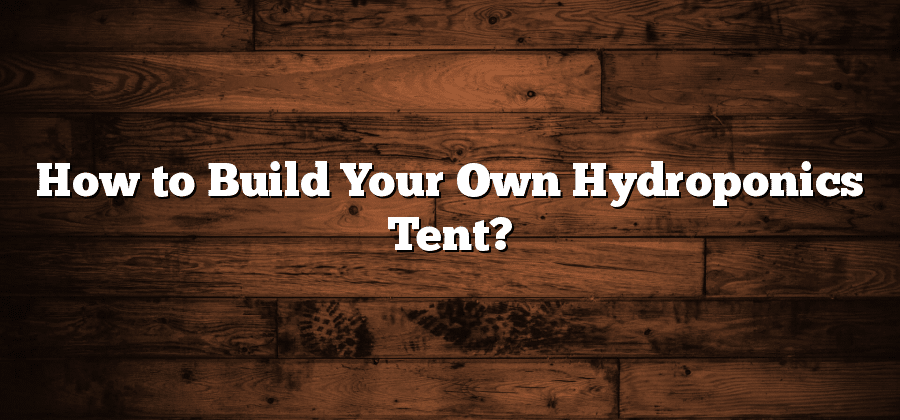Selecting an Appropriate Tent Size
When it comes to setting up an indoor garden, selecting the appropriate tent size is crucial for the success of your plants. The size of your tent will directly affect the number of plants you can accommodate and the overall growth environment for your garden. It is important to choose a tent that provides enough space for your plants to flourish without overcrowding them.
Before selecting a tent size, consider the available space you have in your indoor area. Measure the dimensions of the room and determine how much of that space you are willing to allocate for your gardening needs. Keep in mind that your plants will need space not only for their height, but also for their width as they grow and develop. It is recommended to allow at least a foot of space around each plant to ensure proper ventilation and to prevent plants from shading each other. By carefully assessing your available space and considering the number of plants you want to grow, you can confidently select the appropriate tent size for your indoor garden.
Choosing the Right Lighting System
When it comes to indoor gardening, selecting the right lighting system is crucial for the overall success of your plants. Proper lighting plays a vital role in the growth and development of plants, as it provides the necessary energy for photosynthesis. There are several factors to consider when choosing the appropriate lighting system for your indoor garden.
First and foremost, you need to evaluate the specific requirements of your plants. Different plants have varying light intensity needs, so it’s essential to match your lighting system accordingly. For example, high-intensity discharge (HID) lights, such as metal halide (MH) and high-pressure sodium (HPS) lamps, are ideal for plants in the vegetative stage. On the other hand, during the flowering stage, HPS lamps are preferred to promote blooming and fruit development. LED lights are also gaining popularity in indoor gardening due to their energy-efficient and customizable features. Assessing the light requirements of your plants will guide you in making the right lighting system choice for optimal growth and yield.
Picking the Ideal Growing Medium
The choice of growing medium is a crucial aspect of cultivating plants in an indoor garden. The ideal growing medium provides the necessary support, water retention, and aeration for the plants’ roots to flourish. One popular option is peat-based potting mix, which is made from decomposed organic matter and offers excellent water retention properties. However, it is important to note that peat-based mixes can be slow to rehydrate and may require frequent watering. Another choice is coco coir, a renewable and environmentally-friendly medium made from coconut husks. Coco coir has a high water-holding capacity, good drainage, and promotes healthy root growth.
Furthermore, many gardeners opt for soilless growing mediums such as perlite, vermiculite, or a combination of both. These mediums offer excellent aeration and drainage, reducing the risk of overwatering and root rot. Additionally, they do not contain any pests or diseases commonly found in soil. However, it is important to provide adequate nutrients to plants grown in these soilless mediums, as they do not contain natural fertility.
Selecting the ideal growing medium requires careful consideration of the specific needs of the plants being grown. By providing the necessary support, moisture, and oxygenation, a suitable growing medium sets the foundation for healthy plant growth and successful indoor gardening endeavors.
Setting Up an Efficient Ventilation System
When cultivating plants indoors, setting up an efficient ventilation system is paramount to their health and overall success. Proper air circulation is crucial for maintaining optimal temperature and humidity levels, preventing the growth of mold and mildew, and promoting the exchange of fresh air and carbon dioxide within the grow space.
To begin, it is essential to select the appropriate ventilation equipment for your indoor garden. This includes investing in a high-quality exhaust fan that can effectively remove stale air, odors, and excess heat from the grow room. Additionally, installing intake fans or vents is necessary to bring in clean air and promote a steady flow of fresh oxygen. By ensuring a balanced intake and exhaust system, growers can create an environment that mimics the natural outdoor conditions plants require for healthy growth.
However, it is not enough to simply have the right equipment; the placement of ventilation components is equally as important. Exhaust fans should be strategically positioned near the top of the grow space to efficiently remove hot air, while intake fans or vents can be placed at the bottom to facilitate the intake of cool, fresh air. It is crucial to consider the layout of your indoor garden when determining the optimal location for ventilation equipment. By directing airflow correctly, you can prevent stagnant air pockets and promote uniform temperature and humidity levels throughout the grow space.
Installing an Effective Watering System
One of the most essential components of setting up a successful indoor growing operation is installing an effective watering system. Providing your plants with the right amount of moisture at the right time is crucial for their growth and productivity. A properly designed watering system not only saves you time and effort but also ensures that your plants receive the optimal amount of water without the risk of overwatering or underwatering.
When selecting a watering system for your indoor garden, it is important to consider several factors. First, assess the specific needs of your plants, including their water requirements and preferred watering schedule. Some plants, such as succulents, thrive in drier conditions and require less frequent watering, while others, like tropical foliage plants, may need more frequent watering. Additionally, consider the size and layout of your indoor garden to determine the most efficient and practical system for delivering water. Options range from simple hand-watering techniques to more advanced systems such as drip irrigation or automated hydroponic setups.






